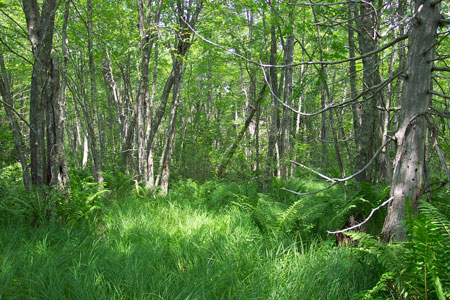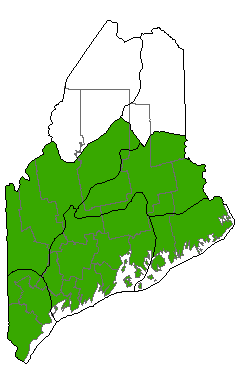DACF Home → Bureaus & Programs → Maine Natural Areas Program → Communities, Plants, and Animals → Natural Community Fact Sheets→Red Maple Fen
Printer Friendly Fact Sheet - 1.1 MB pdf (Get a free copy of Adobe Acrobat Reader)
Red Maple Fen
Scientific Name: Red Maple Wooded Fen; State Rank: S4

- Community Description
- Soil and Site Characteristics
- Diagnostics
- Similar Types
- Conservation, Wildlife and Management Considerations
- Distribution
- Characteristic Plants
- Associated Rare Plants
- Associated Rare Animals
- Examples on Conservation Lands You Can Visit
Community Description: Red maple dominates the canopy of this partly forested peatland, or it may be co-dominant with larch or black spruce. Canopy closure is usually <50%, sometimes to 65%. The shrub layer is locally dense, with small trees and thickets of winterberry, mountain holly, highbush blueberry, or maleberry. Sweetgale and heath shrubs that are typically dwarfed in bog settings grow taller (often >1 m) in this setting. Sedges are characteristic in the herb layer, and cinnamon fern and other wetland plants may be locally common. The bryoid layer is extensive (>60% cover) and dominated by peat mosses. A variant features larch as the dominant canopy tree, but vegetation is otherwise the same. Back to top.
Soil and Site Characteristics: Sites occupy low basins (up to 1000’ elevation) and are typically a peripheral portion of a larger wetland. The saturated soils are organic and the peat layer may be deep (>50 cm). The substrate is less acidic than most true bogs (pH 5.0-5.4). Back to top.
Diagnostics: Sites occur in a peatland setting with red maple dominant in a partial canopy (<65%, usually <50%) or co-dominant with larch or black spruce. Heath shrubs and other characteristic peatland plants are present in shrub and herb layers. The substrate is dominated by Sphagnum moss. Back to top.
Similar Types: Red Maple Swamps can have similar overstory vegetation, but occur on mineral soils (perhaps with a thin peat layer) rather than on a peat substrate, and typically have taller trees with a more continuous canopy; they lack the heath shrubs characteristic of this type. Open Cedar Fens are similar but are dominated by northern white cedar, sometimes mixed with red maple. Black Spruce Bogs occur in similar settings, but generally in more nutrient poor conditions, and have spruce and/or larch much more abundant than red maple in the canopy. Back to top.
Conservation, Wildlife and Management Considerations: These fens usually occur as part of larger peatlands, and maintaining the hydrologic integrity of the entire wetland with upland buffers is key. This community type is widespread and apparently has few or no competing uses.
Birds associated with this community include wetland species such as the common yellowthroat and northern waterthrush. Thaxter’s pinion moth uses larch and sweetgale as its larval host plants and may be found in this community. Back to top.
Distribution: Statewide, less abundant northward; extending westward and southward (and perhaps eastward) from Maine. Landscape Pattern: Large Patch. Back to top.


Characteristic Plants: These plants are frequently found in this community type. Those with an asterisk are often diagnostic of this community.
- Canopy
- Black spruce
- Larch*
- Red maple*
- Sapling/shrub
- Balsam fir
- Rhodora*
- Sweetgale*
- Wild-raisin*
- Winterberry*
- Herb
- Cinnamon fern*
- Goldthread*
- Marsh fern*
- Skunk cabbage*
- Three-leaved false Solomon's seal*
- Three-seeded sedge*
- Tussock sedge*
- Beaked sedge
- Bryoid
- Sphagnum mosses*
There are no documented rare animals associated with this natural community.
Examples on Conservation Lands You Can Visit
| Example | County |
|---|---|
| Appleton Bog Preserve | Knox Co. |
| Middle Pond State Park | Oxford Co. |
| The Heath, Massabesic Experimental Forest | York Co. |